お正月や格式ある日本庭園で耳にする、優雅で気品あふれる「琴」の音色。その清らかな響きは、多くの日本人の心に安らぎと伝統の美しさを感じさせてくれます。しかし、私たちが普段「こと」と呼んでいるこの楽器、実はその多くが「箏(そう)」という楽器であることをご存知でしょうか。この二つの「こと」には、知られざる歴史と構造の違いがあります。その違いを知ることは、日本の伝統音楽の深淵を覗く、興味深い旅の始まりなのです。
- 「琴(きん)」と「箏(そう)」:知られざる二つの「こと」の物語
- 二大流派が生んだ様式美:生田流と山田流の違い
- 古典から現代ポップスまで:千年の時を超えて響く新たな音色
その音色は、日本の原風景を呼び覚ます
「琴」の音と聞くと、多くの人が「さくらさくら」のメロディーや、静かな和室で着物姿の女性が爪弾く姿を思い浮かべるかもしれません。その音色は、日本の雅(みやび)な文化の象徴であり、私たちの心の奥にある原風景を呼び覚ます力を持っています。しかし、一般的に「お琴」として親しまれている楽器の正式名称は「箏(そう)」です。では、本来の「琴(きん)」とはどのような楽器なのでしょうか。この二つは、見た目も演奏方法も異なる別の楽器であり、そのルーツを辿ると古代中国の伝説に行き着きます。
大陸から伝わった龍の楽器
箏の起源は古く、一説には秦の時代の中国で生まれたとされています。その細長い形状は、天から舞い降りた龍をかたどったものだという美しい伝説も残っています。この楽器が日本に伝わったのは奈良時代。雅楽を構成する楽器の一つとして、大陸から渡来しました。当時の日本には、柱(じ)と呼ばれる可動式のブリッジで弦の音程を調節する「箏(そう)」と、柱がなく、指で弦を押さえる場所を変えて音を出す「琴(きん)」の両方が伝わりました。しかし、時代と共に演奏のしやすさなどから箏が主流となり、やがて「こと」と言えば一般的に箏を指すようになったのです。
生田流と山田流、二つの美学が磨いた音
江戸時代に入ると、箏は宮中や寺院の音楽から、町人の間にも広がる大衆的な楽器へと発展しました。この過程で、二つの大きな流派が誕生し、現代まで続く箏の様式美を確立しました。それが「生田流(いくたりゅう)」と「山田流(やまだりゅう)」です。この二つの流派は、使用する爪の形、楽器に対する構え方、そして得意とする音楽のスタイルが異なります。生田流は三味線と共に発展した技巧的な「地歌」を得意とし、一方の山田流は語りを重視する「浄瑠璃」の要素を取り入れた歌ものを得意とします。この二大流派の切磋琢磨が、箏の表現力を豊かにし、芸術性を高めていきました。
今に息づく、千年の音色
箏は、古典音楽の世界に留まることなく、現代の様々なシーンでその音色を響かせています。小中学校の音楽の授業で箏に触れた経験がある方も多いでしょう。これは、箏が日本の音楽文化を学ぶ上で重要な楽器と位置づけられているからです。また、伝統的な楽曲の演奏や継承活動はもちろんのこと、現代の箏奏者たちはJ-POPの楽曲をカバーしたり、ロックバンドやオーケストラと共演したりと、ジャンルの垣根を越えた活動を積極的に行っています。千年以上前に日本に伝わった楽器が、今もなお形を変えながら新しい音楽を生み出し続けているのです。
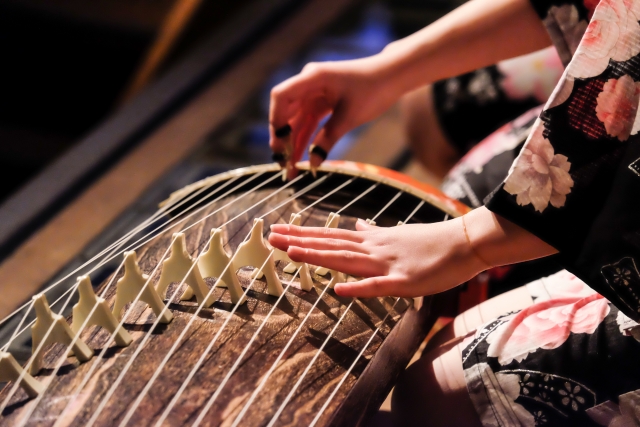
解説ポイント①:「琴(きん)」と「箏(そう)」:知られざる二つの「こと」の物語
私たちが日常で混同しがちな「琴」と「箏」。その明確な違いは、音程を調節するための「柱(じ)」の有無にあります。
- 箏(そう)- Koto (Soh)
- 構造: 弦の下に「柱(じ)」と呼ばれる可動式の支柱を立て、その位置を動かすことで音程を調整します。
- 弦の数: 一般的に十三本の弦を持ちます。現代では十七絃や二十五絃など、より多くの弦を持つ箏も使われます。
- 特徴: 私たちが「お琴」としてイメージする楽器のほとんどがこの「箏」です。柱によってあらかじめ調弦されているため、華やかで多彩な演奏が可能です。
- 琴(きん)- Koto (Kin)
- 構造: 柱がありません。ギターのフレットレスのように、左手の指で弦を押さえる位置を変えることで音程を作ります。
- 弦の数: 七本の弦が基本で、「七絃琴(しちげんきん)」とも呼ばれます。
- 特徴: 非常に繊細で内省的な音色を持ち、古代中国では文人が精神修養のために奏でたとされます。演奏が難しく、現代の日本では演奏者も限られています。
常用漢字表に「箏」の字が含まれなかったことなどから、次第に「琴」の字が代用され、混同が一般化したと言われています。
解説ポイント②:二大流派が生んだ様式美:生田流と山田流の違い
江戸時代に確立された生田流と山田流。その違いを知ることで、箏曲の楽しみ方が一層深まります。
| 生田流(いくたりゅう) | 山田流(やまだりゅう) | |
| 発祥 | 17世紀末に生田検校が創始 | 18世紀末に山田検校が創始 |
| 爪の形 | 角爪(かくづめ):四角い形状 | 丸爪(まるづめ):先端が楕円形 |
| 構え方 | 楽器に対して斜めに座る | 楽器に対して正面に座る |
| 音楽的特徴 | 三味線との合奏音楽「地歌」を中心に発展。技巧的でリズミカル、華やかな曲が多い。 | 「浄瑠璃」などの語り物の影響を強く受け、歌を重視する「歌もの」が中心。おおらかで叙情的な曲が多い。 |
この二つのスタイルは、どちらが優れているということではなく、異なる美学を追求した結果です。現代では、流派の垣根を越えて様々な曲が演奏されています。
解説ポイント③:古典から現代ポップスまで:千年の時を超えて響く新たな音色
箏の可能性は、古典の世界にとどまりません。現代のアーティストたちは、その伝統的な音色を活かしながら、全く新しい音楽を生み出しています。
- 多様な音楽ジャンルとの融合 「和楽器バンド」のようにロックバンドのサウンドに箏を取り入れたり、若手箏奏者のLEO氏がクラシックや現代音楽のフィールドで活躍したりと、箏はジャンルを横断する楽器へと進化しています。YouTubeなどでは、人気のアニメソングやJ-POPを箏でカバーした動画が数多く投稿され、国内外で人気を博しています。
- 楽器の進化 伝統的な十三絃箏に加え、低音域を豊かに響かせる「十七絃箏」や、さらに広い音域と複雑な和音を可能にする「二十五絃箏」といった新しい楽器が開発されています。これにより、箏で表現できる音楽の幅は飛躍的に広がり、現代の作曲家たちに新たなインスピレーションを与えています。
- 教育と文化の担い手として 日本の多くの学校では、音楽の授業で箏を演奏する機会が設けられています。これにより、子供たちは自国の伝統音楽に直接触れることができます。箏は、単なる演奏楽器としてだけでなく、日本の文化を次世代に伝える大切な役割も担っているのです。
参考文献
【English Article】
Beyond the Graceful Melody: Discovering the Profound World of the Koto and its True Identity
The elegant and refined sound of the “koto,” heard during New Year’s celebrations or in formal Japanese gardens, brings a sense of peace and traditional beauty to the hearts of many Japanese people. However, did you know that the instrument we commonly call the “koto” is, in fact, mostly a different instrument called the “sō”? These two types of “koto” have their own hidden histories and structural differences. Understanding these distinctions is the beginning of a fascinating journey into the depths of traditional Japanese music.
- “Kin” and “Sō”: The Tale of Two “Koto”
- The Aesthetic Styles Born from Two Major Schools: The Differences Between Ikuta-ryū and Yamada-ryū
- From Classics to Modern Pop: A New Sound Resonating Through a Thousand Years
Its Timbre Evokes the Original Landscape of Japan
When people hear the sound of the “koto,” many may imagine the melody of “Sakura Sakura” or a woman in a kimono plucking the strings in a quiet Japanese-style room. Its sound is a symbol of Japan’s elegant “miyabi” culture and has the power to awaken the nostalgic landscapes deep within our hearts. However, the official name of the instrument popularly known as the “okoto” is the “sō.” So, what is the original “kin”? These are two different instruments with distinct appearances and playing methods, and tracing their roots leads us to the legends of ancient China.
The Dragon Instrument from the Continent
The origin of the sō is ancient, with one theory suggesting it was born in China during the Qin dynasty. A beautiful legend says its long, slender shape is modeled after a dragon that descended from the heavens. This instrument was introduced to Japan during the Nara period as one of the instruments in “Gagaku,” the court music. At that time, both the “sō,” which adjusts pitch using movable bridges called “ji,” and the “kin,” which has no bridges and changes pitch by pressing the strings at different points with the fingers, were introduced. However, over time, the sō became mainstream due to its ease of playing, and eventually, the word “koto” came to generally refer to the sō.
The Sound Polished by the Aesthetics of Two Schools: Ikuta-ryū and Yamada-ryū
In the Edo period, the sō evolved from an instrument of the imperial court and temples into a popular instrument among the townspeople. During this process, two major schools were established, shaping the aesthetic style of the sō that continues to this day: the “Ikuta-ryū” and the “Yamada-ryū.” These two schools differ in the shape of the plectrums (claws) they use, their posture towards the instrument, and the style of music they specialize in. The Ikuta-ryū excels at technical “jiuta” pieces developed alongside the shamisen, while the Yamada-ryū specializes in song-based pieces that incorporate narrative “jōruri” elements. The friendly rivalry between these two major schools enriched the expressive power of the sō and elevated its artistry.
A Thousand-Year-Old Timbre, Alive Today
The sō is not confined to the world of classical music; its sound resonates in various modern scenes. Many people may have experienced playing the sō in music classes in elementary or junior high school. This is because the sō is positioned as an important instrument for learning about Japan’s musical culture. In addition to performing and passing down traditional pieces, contemporary sō players are actively engaged in cross-genre activities, such as covering J-pop songs and collaborating with rock bands and orchestras. The instrument, introduced to Japan over a thousand years ago, continues to evolve and create new music today.
Analysis Point ①: “Kin” and “Sō”: The Tale of Two “Koto”
The “kin” and “sō” are often confused in daily life. The clear difference lies in the presence or absence of “ji,” the bridges used to adjust pitch.
- Sō – Koto (Soh)
- Structure: It has movable bridges called “ji” under the strings. The pitch is adjusted by moving their positions.
- Number of Strings: Typically has thirteen strings. Modern versions with more strings, such as the 17-string (jūshichigen) and 25-string (nijūgogen) sō, are also used.
- Characteristics: This is the instrument that most people picture when they think of the “okoto.” Because it is pre-tuned by the bridges, it allows for brilliant and varied performances.
- Kin – Koto (Kin)
- Structure: It has no bridges. Like a fretless guitar, the pitch is changed by altering the position where the strings are pressed with the fingers of the left hand.
- Number of Strings: It is fundamentally a seven-string instrument, also known as the “shichigenkin.”
- Characteristics: It has a very delicate and introspective tone and was said to be played by scholars in ancient China for spiritual cultivation. It is difficult to play, and performers are limited in modern Japan.
It is said that the confusion became common because the character for “sō” (箏) was not included in the list of commonly used kanji, leading to the character for “kin” (琴) being used as a substitute.
Analysis Point ②: The Aesthetic Styles Born from Two Major Schools: The Differences Between Ikuta-ryū and Yamada-ryū
Understanding the differences between the Ikuta-ryū and Yamada-ryū, established in the Edo period, deepens the enjoyment of sō music.
| Ikuta-ryū | Yamada-ryū | |
| Origin | Founded by Ikuta Kengyō at the end of the 17th century | Founded by Yamada Kengyō at the end of the 18th century |
| Plectrum Shape | Kakuzume (square plectrums) | Maruzume (oval plectrums) |
| Posture | Sits diagonally to the instrument | Sits directly in front of the instrument |
| Musical Features | Developed mainly with “jiuta,” ensemble music with the shamisen. Features many technical, rhythmical, and brilliant pieces. | Strongly influenced by narrative styles like “jōruri,” focusing on “utaimono” (song-centric pieces). Features many broad and lyrical pieces. |
These two styles are not about which is superior, but are the result of pursuing different aesthetics. Today, musicians often perform pieces from beyond their own school’s repertoire.
Analysis Point ③: From Classics to Modern Pop: A New Sound Resonating Through a Thousand Years
The potential of the sō is not limited to the world of classical music. Contemporary artists are creating entirely new music while utilizing its traditional tone.
- Fusion with Diverse Musical Genres The sō is evolving into a cross-genre instrument, as seen with groups like the “Wagakki Band” incorporating it into their rock sound, and young players like LEO excelling in the fields of classical and contemporary music. Many videos covering popular anime songs and J-pop on the sō are posted on platforms like YouTube, gaining popularity both domestically and internationally.
- Evolution of the Instrument In addition to the traditional 13-string sō, new instruments have been developed, such as the “17-string sō” (jūshichigen-sō) which provides a rich lower register, and the “25-string sō” (nijūgogen-sō) that allows for a wider range and more complex chords. These developments have dramatically expanded the range of musical expression possible on the sō, providing new inspiration to contemporary composers.
- As a Bearer of Education and Culture In many Japanese schools, students are given the opportunity to play the sō in music class. This allows children to directly experience their country’s traditional music. The sō plays an important role not only as a performance instrument but also as a vital means of transmitting Japanese culture to the next generation.

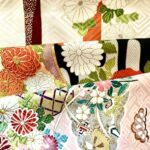
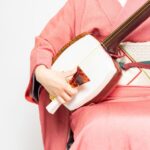

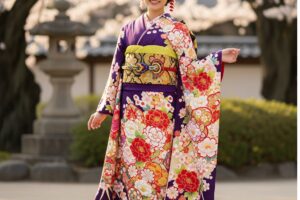
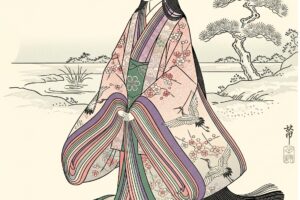

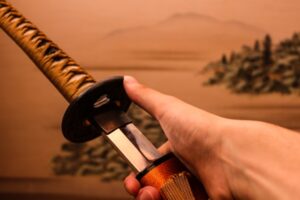

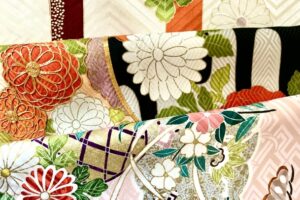

コメントを残す